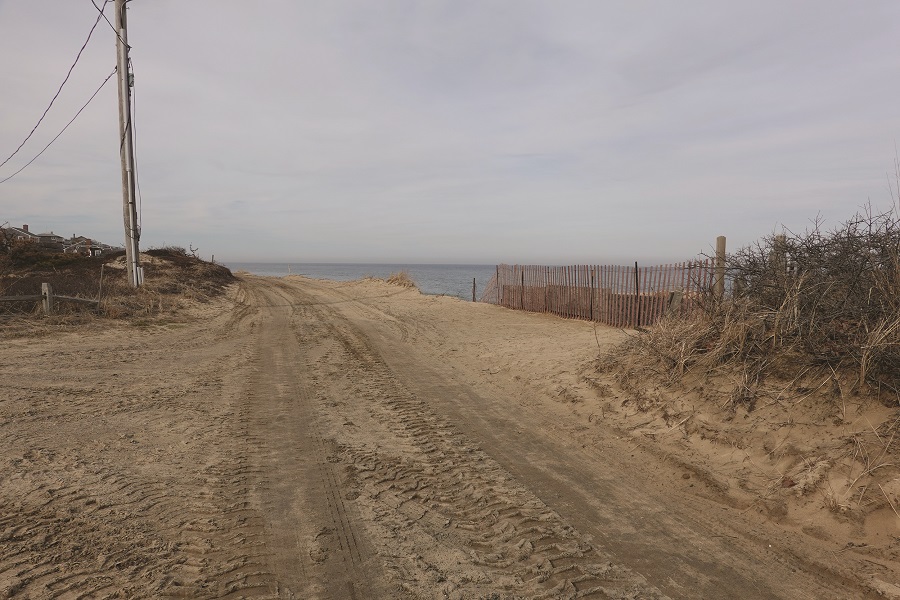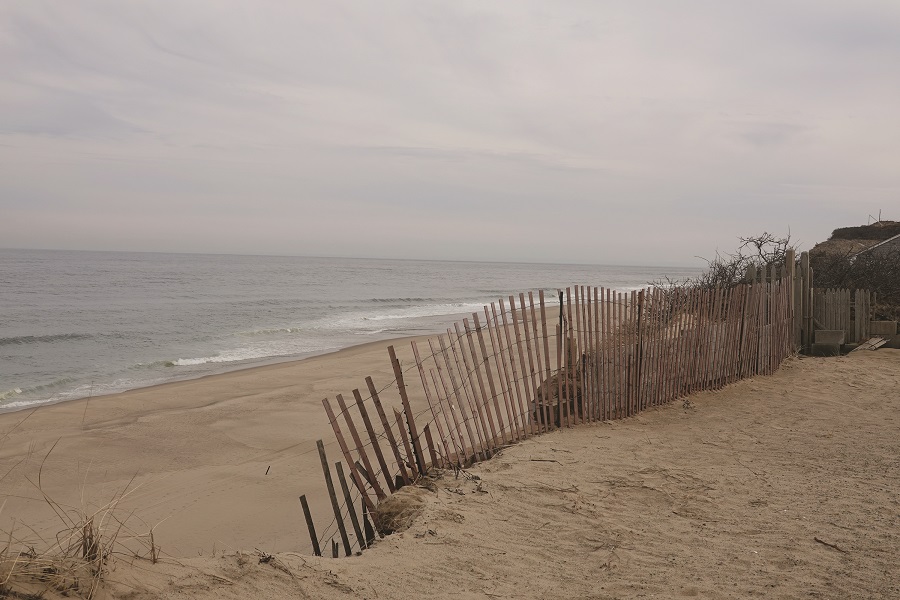WELLFLEET — After two January nor’easters, an eroding road has cut off six oceanfront property owners from access to their houses.
“Each storm compromises the area even further,” said Douglas Freeman of Newton, whose house at 331 North Circuit Road is reached via Priscilla Road and Cliff Road, sand tracks overlooking the ocean between White Crest Beach and Lecount Hollow. Those roads have narrowed to the point that they are unsafe for cars, much less for trucks to refill the propane tanks that provide heat and hot water.
“Three years ago, my neighbors and I knew the erosion was going to be an issue, compromising access,” Freeman said. “There’s a pinch point where Priscilla Road meets Cliff Road. It looked like we would have to find an alternate means of egress for the six existing homes and a separate deck.” (Freeman is an investor in the Provincetown Independent.)

He proposed a solution: open up two roads that exist only on paper. The roads appear on maps drawn up in 1915 as Alden Road and North Circuit Road but were never built. Freeman had the paper roads surveyed and an engineered plan created; permits and approvals were secured from the Cape Cod National Seashore, the state’s Natural Heritage and Endangered Species Program, and Wellfleet’s police and fire departments.
But Freeman, who says he uses his Wellfleet house for nine months of the year, can’t proceed with his plan because of a lawsuit filed in Barnstable Superior Court by abutters of one of the proposed roads — members of the Morrow family, who own a house at 270 Ocean View Drive.
The Morrows’ suit demands monetary damages and that the plan for the new access roads be approved by the Wellfleet Planning Board.
Construction of the roads “could lead to a lot of erosion that could undermine people’s properties, including my clients’,” said Christopher Senie of Brewster, the Morrows’ lawyer. Senie claimed in a letter to the planning board that the planned roads had “slopes that far exceed prevailing standards for maximum road grades and are likely to cause very significant erosion in a sensitive area.” Senie also raised concerns about the effects of road construction on septic systems, wells, and stormwater management.
Freeman said no abutters other than the Morrows had raised objections to his plan. “My understanding is that this is pure NIMBYism,” he said.
“I want this to be as smooth and harmonious as possible,” said Eugenia Morrow, one of the plaintiffs. “We were hoping to have dialogue at the planning board meeting, to bring it up that way and work together.” Other family members referred requests for comment to their attorney.
Dream House Sold for $1
Erosion on the Outer Cape’s back shore is nothing new. In February, a house on Ballston Beach in Truro was close to collapse after the same January storms scoured 54 feet from the bluff beneath it. Like the Ballston house, many houses in the Priscilla Road neighborhood have been moved back at least once.
“As a rule of thumb, a sandy shoreline retreats landward about 100 feet for every one-foot rise in sea level,” according to the Cape Cod Commission’s most recent Climate Action Plan. “Therefore, based on local sea level rise projections, the Cape may experience between 400 to 1,000 feet of shoreline retreat by the end of the century.”
Melinda Krasting said the house she owned on the ocean side of Cliff Road was “like a best friend.”
It’s where she would go “to watch the moon rise over the water and wake up and watch the whales breach right outside.” When she bought the house in 1998, she recalled, it was “so far from the edge.”

For the first few years there was no real erosion, she said. Then the Cape was hit with severe storms two years in a row.
“Suddenly, I found myself five feet from the edge of the cliff,” Krasting said. She started a two-year process of moving her house back.
In the initial move, she had 25-foot-deep pilings installed, but by 2013 all the land was scoured out from under the house and there was no more room to move it back.
“The house was condemned,” she said. She sold it to her neighbor, Robert Boehringer, for $1. He had it moved to his property and now uses it for short-term rentals.
Even after selling the house and moving to Truro, she would come to Cliff Road to sit on the last remnant of her deck nearly every day. Then, a month ago, the deck went, too. She hasn’t visited since.
Krasting supports Freeman’s efforts to make the paper roads real. “I don’t see how anybody could object to them,” she said. If they are built, she added, and as long as there’s room to plop down a chair on what’s left of her property, she’ll go and watch the ocean.
A Continuing Problem
Planning board chair Gerry Parent said that, for the 28 years he has served on the board, it has never taken a position on previously laid out subdivisions. He added, though, that the town counsel had advised that it is permitted to do so.
“We never wanted to review those pre-existing subdivisions unless a new lot was being created within that subdivision,” Parent said.
Attorney Senie, representing the Morrows, tried to address the planning board at its March 2 meeting, but was cut off by Parent. Board member Olga Kahn objected. “I think he has a point and I would like to hear him,” she said. Parent replied, “He doesn’t have a point.”
While the grades of the proposed roads are steeper than the town’s rules allow, “There’s not an alternative,” Parent said. “If there is a discussion between the two parties — one feeling they want more information and are aggrieved and the other who needs to get those roads open — that’s quite honestly between those parties and not the business of the planning board.”
As erosion progresses, “these issues are only going to become more common,” said board member David Mead-Fox. It will be important to keep the door open for discussion of these issues, he suggested.
“There’s going to be things that will make this look like child’s play, like when we start talking about what will happen to Commercial Street,” Mead-Fox said.



